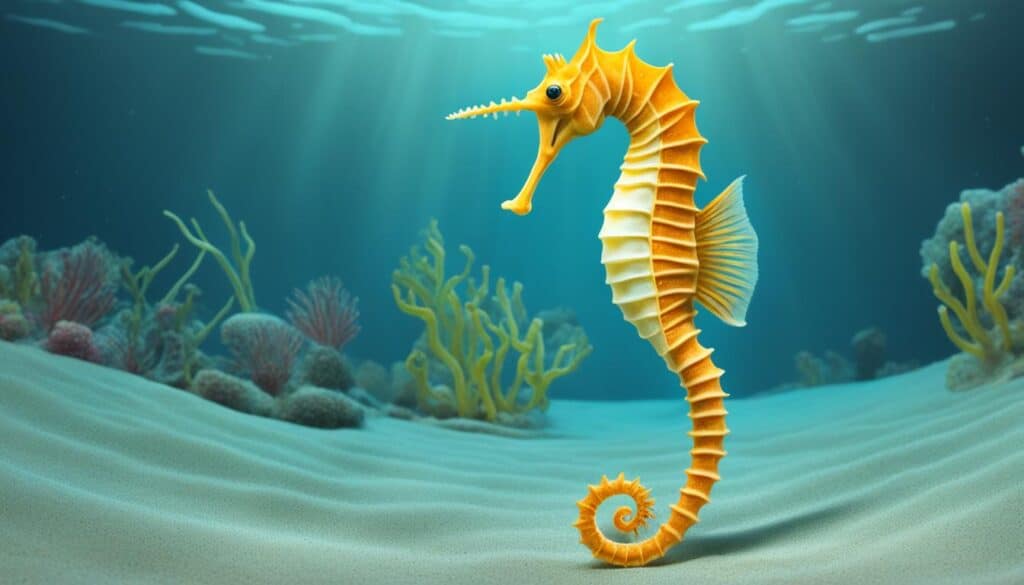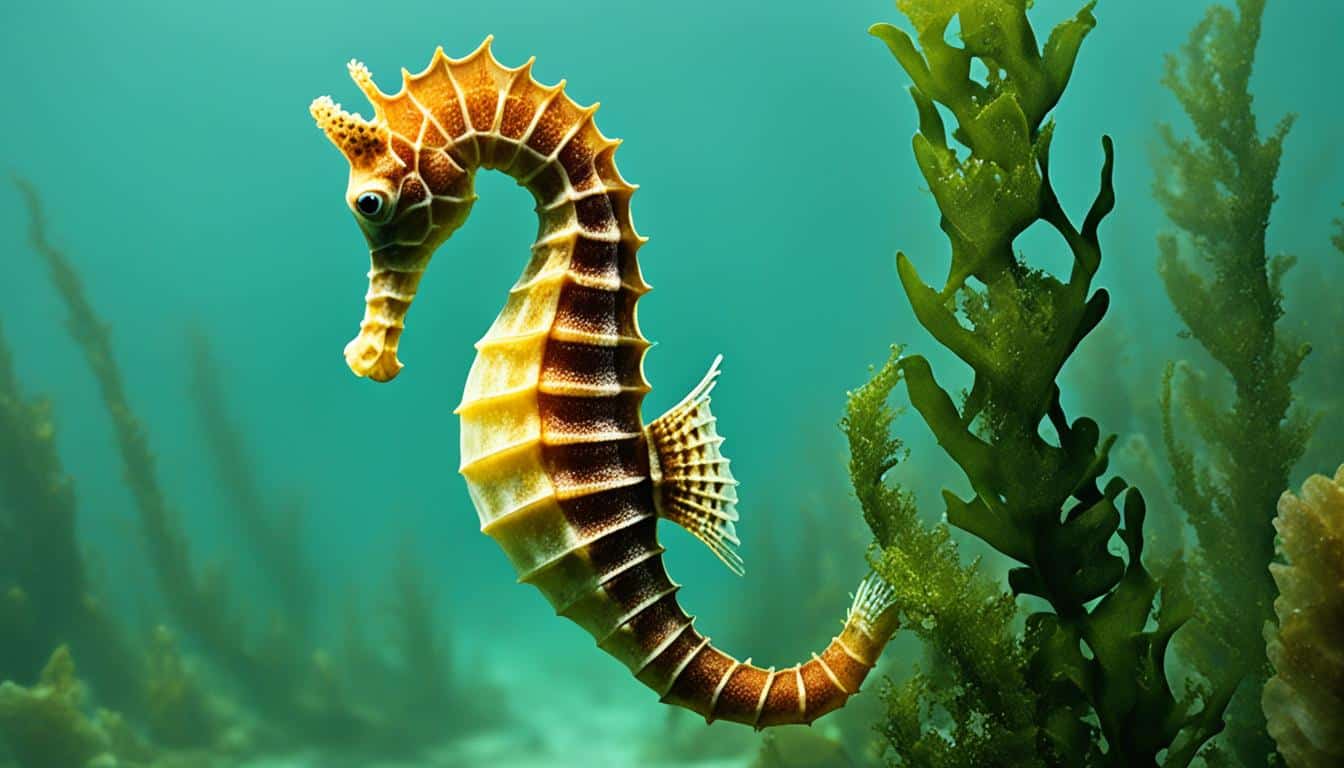Seahorses use their tails for more than just looks. You might ask, how do seahorses use their tails? These fish have a special tail that helps them survive. It lets them stick to things in their world, keeping them safe from currents and predators.
This is key since they can’t swim fast like other fish. Knowing how seahorses use their tails helps us understand their special body parts. It also shows why their tails have evolved this way.
The Unique Function of the Seahorse Tail
The seahorse tail has a special role that sets it apart from other sea creatures. It’s not just for swimming. The tail is prehensile, meaning it helps the seahorse hold onto things in its environment.
Prehensile Tail Abilities
The seahorse tail is very flexible. It lets seahorses stick to seagrass and coral. This is key in rough waters where staying steady is important. The muscles in the tail help keep a strong grip, so seahorses don’t get swept away by currents.
Comparison to Other Marine Creatures
When we look at the seahorse tail versus those of octopuses or fish, the differences stand out. While traditional tails are made for swimming, the seahorse tail is for stability and catching onto things. This special tail helps seahorses avoid predators and find food in their home.
| Feature | Seahorse | Octopus | Traditional Fish |
|---|---|---|---|
| Tail Type | Prehensile | Flexible | Propulsive |
| Primary Function | Grasping and anchoring | Movement and flexibility | Swimming efficiency |
| Adaptability | High | Moderate | Low |
How do seahorses use their tails?
Seahorses have a special way of using their tails that is key to their survival and how they interact with their world. Their tails are vital for staying stable and helping with everyday tasks, like finding food.
Anchoring for Stability
One main job of their tails is to anchor them in place. Seahorses stick to seagrasses, corals, and other things on the sea floor. This keeps them from being carried away by strong currents. It lets them stay put while they look for small shrimp and other food.
This tail function is crucial for their survival. It helps them forage safely, keeping them away from the dangers of their environment.
Grasping Objects in Their Environment
Seahorses also use their tails to hold onto things in their world. Baby seahorses do this right from the start, holding onto objects for safety. Adults use their tails in social situations, like during mating, to connect and feel secure.
This ability to grasp things is vital for their survival and how they interact with others in the sea.
Seahorse Tail Anatomy
The seahorse tail is unique and plays a big role in its survival in the ocean. It’s made in a way that helps it move and stay strong. Let’s dive into what makes the seahorse tail special.
Structure of the Tail
A seahorse’s tail is made up of many small bones. These bones are covered in special plates that fit together like a puzzle. This design lets the tail be flexible yet strong. It’s different from the round tails of other sea creatures.
This special tail helps the seahorse avoid getting hurt by predators. It’s a key part of what makes the seahorse so hard to catch.
Square vs. Circular Tail Cross-Sections
Seahorses have square tails, unlike the round ones found on other sea animals. This shape is great for several reasons:
- Enhanced durability: The square edges spread out stress better.
- Improved grip: The square shape helps the seahorse hold onto things.
- Flexibility under pressure: It can bend and twist without breaking.
Round tails don’t handle pressure as well as square ones. The seahorse’s tail is a big reason why they can live in the ocean.
| Feature | Seahorse Tail | Other Marine Creatures |
|---|---|---|
| Cross-Section Shape | Square | Circular |
| Durability | High | Moderate |
| Flexibility | High | Variable |
| Anchoring Ability | Superior | Standard |

Seahorse Tail Movement
Seahorse tail movement is key to understanding their special ways in the water. They can’t swim like most fish because of their bony bodies and weak caudal fin. Instead, they use their tails to stay stable and navigate on the sea floor.
Limitations of Swimming
Seahorses have a unique body shape that limits their swimming. Their tails don’t help with swimming. They use them for small movements to stay steady in rough waters. This is crucial for catching prey, as they need to be still to wait for food.
Importance in Mobility
Seahorse tail movement is vital for their movement. Their square tails help them grip and twist around things, giving them support as they move. This helps them overcome their swimming limits, letting them live in different ocean habitats. The special design of their tails is key to their survival, showing how they interact with their world.
FAQ
How do seahorses use their tails?
Seahorses use their tails to anchor themselves to things like sea grasses and coral. This helps them stay put in choppy waters while they look for food. It’s a key way they survive.
What is the function of a seahorse tail?
Seahorse tails have many jobs. They help the fish stay in place, protect them, and don’t help with swimming. But they’re vital for keeping the seahorse stable in its world.
How are seahorse tails adapted to their environment?
Seahorses have a special tail that can grab onto things. This lets them hold onto sea grasses and coral, keeping them from being swept away by currents. It also helps them hide from predators.
Can you describe the anatomy of a seahorse tail?
The seahorse tail is made up of special bones that fit together in an L-shape. This shape makes the tail strong and able to handle a lot of pressure. It helps the seahorse stay safe in the water.
What makes the seahorse tail different from other marine creatures’ tails?
Seahorses have a square-shaped tail, unlike most fish and sea creatures. This shape lets them twist and grip things, which is key for anchoring and moving around.
How does the seahorse tail contribute to mobility?
The seahorse tail helps with balance on the sea floor. It moves in ways that help the seahorse move around, even though it can’t swim very fast. This is because they don’t have a strong tail fin.
How do baby seahorses use their tails when they are born?
Baby seahorses use their tails to hold onto things right after they’re born. This helps them stay stable in the water as they get used to their new life.
How do seahorses employ their tails in social behaviors?
Adult seahorses use their tails to hold onto each other during mating. This shows how important their tails are not just for living but also for interacting with others in their group.







